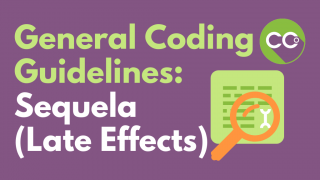 In this article, we’re going to go over three (3) example cases and assign them the sequela and late effect.
In this article, we’re going to go over three (3) example cases and assign them the sequela and late effect.
As a reminder, a sequela is the residual effect (condition produced) after the acute phase of an illness or injury has terminated. There is no time limit on when a sequela code can be used. The residual may be apparent early, such as in cerebral infarction, or it may occur months or years later, such as that due to a previous injury. So, if a person was to get sick with a disease and after the disease is gone they still have problems, the leftover problem is called a sequela or a late effect. Let’s jump into the 3 examples we’re going to use:
This is in regards to the general coding guidelines of late effects or sequela now in ICD-10.
Sequela Case #1: Keloid Scar Left Forearm Resulting from Second-Degree Burns; Injury Occurred 1 Year Ago
Which of this is the sequela and which is the cause? Make sure you’re identifying the correct main term in the Index, verifying in the Tabular, and reading all the notes, instructional notations in the Tabular. Remember, when we’re talking about late effects, the main term in the Index should be sequela or late effect. Let’s identify what’s the sequela and what’s the code.
Sequela Case #1: Answers
This is pretty straight-forward for one. I’m reading that the scar is resulting from the second-degree burn from over a year ago. The correct code for the scar is L91.0. Now we need our cause code for the second-degree burn, which is the cause. So late effect of a second degree burn. Potential answers are T22.212S and T22.222S but obviously there’s a difference there. “S” is obviously identifying the sequela and I’m guessing the 212 and the 222 is perhaps the degree. The correct code for the second-degree burn is T22.212S.
Let’s try our second one:
Sequela Case #2: Traumatic Arthritis in The Right Ankle Joint Due to Previous Nondisplaced Lateral Malleolar Fracture
This is the same concept as the last example. Try to use the same reasoning to identify what’s the sequela and what’s the code.
Sequela Case #2: Answers
Ok, what is the first code for the traumatic arthritis in the right ankle joint? The correct code is M12.571.
What is the second code or late effect of the fracture, the previous nondisplaced lateral malleolar fracture and that’s the sequela… we haven’t found yet? Believe me, this will all be worth it. I know it might feel a little overwhelming right now and still brand new. Again, I will reiterate this is material you will need to read more than once and in order to understand the information you have to apply the information, do the exercises, perhaps 2, 3, 4, 5, 6 times.
We got some codes coming in, let’s see what we’ve got here, S82.64XS, S82.64S – I think Antonia you maybe meant to put the X in there because it goes with the 7th character. If there’s no 6 digit, we put that placeholder of X in there. So, the correct code is S82.64XS.
Sequela Case #3: Oropharyngeal Phase Dysphagia Due to Cva 3 Months Ago
What is our first code? We’re waiting for the code for oropharyngeal phase dysphagia due to CVA 3 months ago. Pay attention to your instructional notations in the Tabular. Let’s identify what’s the sequela and what’s the code.
Sequela Case #3: Answers
Well, R13.12 is the correct code and your I69 code is the one that needs to go first, and you would know that by reading the Tabular; so I69.391 and our R13.12. The actual dysphagia is R13.12, and the late effect sequela is I69.391, but that is told by the instructional notations in the tabular to sequence first. That was a little trickier. Any questions on that one? If so, please post in the comments.
![[CCO] Certification Coaching Organization LLC [CCO] Certification Coaching Organization LLC](https://www.cco.us/wp-content/uploads/2015/05/CCO-Logo-2015-d3-500px.png)
Thank you so much for the Awesome information.
God bless you and have a great day,
Christi
Thank you, you make it so simple. I especially move how you explain the steps.
What a great information-just in time! Thank you for clarifications! But I have a question: do we still need to use 7th character in CVA code (I69.931S?) in Case#3?
I hope this comes through as a reply to Anna but to answer your question I think (I’m currently studying to be certified as a CPC), the 7th character is not required for code (I69.931) and we know this because when we look at the code in the tabular list for I69.931, we do not see a 7th character code symbol listed next to the code. Therefore, we know this code is complete without the 7th character. Hope this helps!
Thanks, Jon!
Thank you
what if a patient had a stress fracture due to arthroscopic procedure? would the stress fracture be a sequela?
No, the stress fracture would be a complication of the procedure.
How about Dementia due to Previous TBI? Code Dementia in other disease NEC (F02.811) and S06.9XAS (TBI). The dementia code is a manifestation code with Code first for TBI. which code should be the PDx?
You code the TBI first followed by the F02.8 code.
F02.811 – Dementia in other diseases classified elsewhere, unspecified severity, with agitation
Code First:the underlying physiological condition:
traumatic brain injury (S06.-)